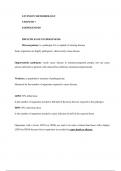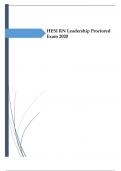Summary
Summary Ch 7; Pathogenesis Levinson 17th Ed
- Course
- Institution
- Book
Concise, easy to grasp immunology overview. Information needed to understand the module present in high level English grammar . Contains method of telling which does not require a prior reading of chapter from book. Well understood by first-time readers or for pre-exam revision. Well detailed summa...
[Show more]












